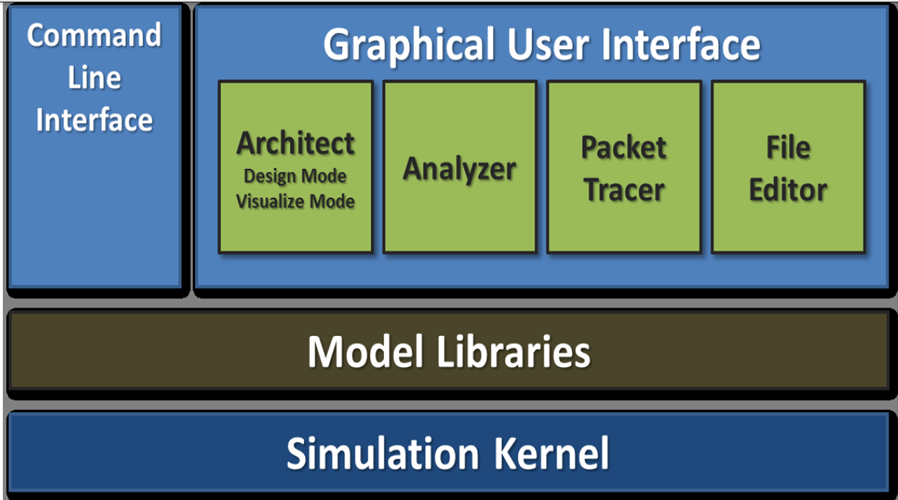
QualNet enables the evaluation of on-the-move communication networks faster and with more realism than any other tool. It uses a network digital twin to digitally represent the entire network, the various protocol layers, radios, antennas, and devices. QualNet employs state of the art Parallel Discrete Event Simulation (PDES) algorithms designed to leverage multi-core and parallel processors to dramatically increase the event processing rate and hence simulation execution speeds to run high-fidelity simulations of large networks at faster than real-time speeds.
The QualNet network simulation platform (QualNet) is used by planners, analysts, IT technicians, and communication specialists to evaluate the performance of communication networks under different operational conditions and to identify and mitigate identified operational issues. The analysis proceeds by first creating a simulation model, or scenario, representing the network and its operating environment, executing the scenario and analyzing the results.

The major features of QualNet include the following:
- QualNet can model a variety of heterogeneous networks (wired, wireless, under-water, satellite, etc.) with thousands of nodes exchanging different types of traffic. These scenarios can run at faster than real-time speed, making it possible to quickly perform “what-if” analysis of the network’s performance under different operating conditions.
- QualNet supports a large number of high-fidelity models for network devices, protocols from all layers of the protocol stack, applications, terrains,
propagation models, and mobility models. The model library includes models for wireless technologies (e.g., Wi-Fi and WiMax); cellular networks (e.g.,
A typical scenario is comprised of:
•Nodes representing network elements and endpoints (routers, switches, radios, sensors, PCs, servers, satellites, ground stations, mobile phones, access points, etc.) and the protocols running on them
•Links that connect the nodes (buses, LAN segments, radio transmissions, Wi-Fi signals, LTE connections, etc.)
•Environment in which the network operates (indoors, rural, or urban environment, weather, etc.)
•Mobility patterns, if any, of the communication devices
•Applications and other sources of traffic operating on the network
Find us at www.keysight.com Page 2
GSM, UMTS, LTE, and 5G); military waveforms (e.g., Link-11, Link-16); satellite communications; underwater communications; devices such as routers, switches, and access points; indoor, rural, and urban terrain; and many real-world applications. Thus, real-world commercial and tactical networks operating in multiple domains can be modeled and analyzed in QualNet at a high level of fidelity. - QualNet’s Human-in-the-Loop (HITL) interface supports dynamic interactions to modify the operations of a running scenario. For example, users can activate/deactivate nodes and modify the traffic rate of certain applications via the HITL interface.
- The QualNet VR-Link interface allows QualNet to network with other constructive simulators, virtual reality applications, and Computer-Generated Force (CGF) tools, such as OTB and OneSAF, using High Level Architecture (HLA) or Distributed Interaction Simulation (DIS).
- The QualNet GUI can be used to visualize different types of packet flows as the scenario is running to provide an operational view of the network. Dynamic statistics can also be displayed while a scenario is running.
- Orientation change extension FFC for Standard SIM
- QualNet’s Analyzer can be used to plot hundreds of metrics post simulation. QualNet also provides for the generation of detailed time-stamped tables in an SQL database, from which queries and reports such as connectivity among nodes, throughput, latency, path loss, packet drop, etc., can be produced. Third-party tools, such as Tableau, can also be used to create reports from the statistics database.
- QualNet’s heatmap feature can be used to refine a network layout based on the signal coverage of wireless transmitters in the scenario, which can be displayed graphically.
- The QualNet framework is highly flexible and extensible: models for new protocols, devices, and applications can be easily developed and incorporated in simulation scenarios. High-fidelity models can also be developed by incorporating actual code from protocol implementation.
